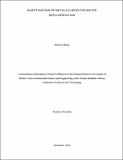| dc.description.abstract | Fluorosis is a significant ailment that affects millions of humans and animals, especially in low income countries. It has been the focus of past and present scientific endeavours to research and
develop efficient and deployable technologies, especially in these low-income communities. In
this work, metallic Iron (Fe0
) is a promising technology, and its filters have successfully
addressed both safe drinking water and sanitation and are frugal. The recalled science of Fe0
filters is demonstrated with the lingering design investigations. This study aimed at the critical
assessment on defluoridation efficiencies under conventional metallic iron aqueous systems;
where at first, Fe0 materials were characterized with 1,10 Phenanthroline (Phen) in aqueous
condition, and later batch studies were realized at the laboratory scale for two days under varied
experimental conditions of: (a) 0.1 g and 1.0 g of iron mass, (b) Equimolar contamination,
23±2.0 mg/L, of co-solutes, i.e. NO3, PO4, SO4, HCO3, Cl, (c) Initial pH values of 4.5, 7.0 and
9.5, and (d) Disturbed and non-disturbed treatments. Characterization results proved the
potential of 1,10-Phenanthroline as a sole Fe0
novel and facile characterization method.
Defluoridation results revealed a maximum of 94% and 47% for quantitative (involving co precipitation, adsorption and occasionally size-exclusion remediations) and non-quantitative
(associated with adsorption as major remediation means) fluoride removal efficiencies,
respectively. Thus, a conventional metallic iron aqueous system requires incorporating
suggested nano-scale practices towards enhancing efficiency for affordable defluoridation
achievements in future continuous system designs. | en_US |

